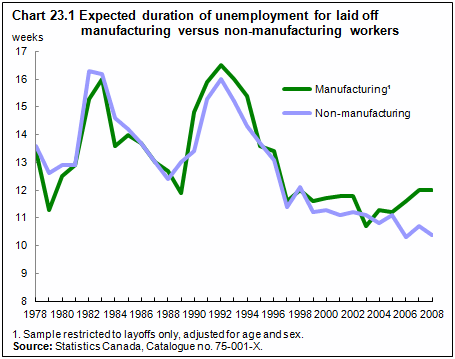Manufacturing
Archived Content
Information identified as archived is provided for reference, research or recordkeeping purposes. It is not subject to the Government of Canada Web Standards and has not been altered or updated since it was archived. Please "contact us" to request a format other than those available.
Related information
In 2010, manufacturers enjoyed their first annual sales increase since 2006, as sales rose 8.9% to $530 billion. Sales grew substantially in the first half of 2010, but the growth slowed toward year-end. Provincially, sales increased the most in New Brunswick (21.2%) and in Newfoundland and Labrador (18.1%).
The primary metals (23.8%) and the petroleum and coal products (15.2%) industries recorded the largest sales growth for the year.
Despite the sales increase, manufacturing employment fell by 375,000 workers in 2010, bringing employment in the sector down to 1.7 million workers, 2.1% below its 2009 level.
Shrinking employment
Shrinking employment in manufacturing is a common trend in almost all OECD countries. From 1998 to 2008, the United States lost close to one-quarter (4.1 million) of its manufacturing jobs. Elsewhere in the OECD, from 1990 to 2003, manufacturing employment fell by 29% in the United Kingdom, 24% in Japan, 20% in Belgium and Sweden and 14% in France.
Canada's manufacturing industry lost 278,000 jobs (1 in 6) from 2000 to 2007, which reduced the sector's share of total employment from 16% to 12%. That share then declined to 10% in 2009 after the 2008–2009 recession when manufacturers faced weaker demand and cuts to industrial capacity, resulting in the loss of 188,000 jobs.
Regions where employment is highly concentrated in the manufacturing sector—mainly in Quebec and Ontario—experienced the greatest manufacturing job losses. From 2000 to 2007, Canadian manufacturing workers aged 20 to 29 in these regions were the most affected by the employment decline in this sector, as they were up to twice as likely to experience a loss of income as those holding a comparable job in a region with a low concentration of manufacturing.
In addition, job security deteriorated in regions of high manufacturing concentration in 2007, leaving workers at greater risk of unemployment and more likely to be receiving Employment Insurance (EI) benefits. Manufacturing workers in these regions were 39% more likely to receive EI benefits than their counterparts in regions with a low concentration of manufacturing.
Job stability gap widens
Recent job losses in manufacturing were accompanied by a drop in job stability and longer unemployment spells—trends seen in previous recessions. This time, however, the gap between manufacturing and non-manufacturing job stability grew and has never been so wide. Voluntary quits tend to go down in times of economic slowdown, so this decrease in manufacturing job stability was likely driven by layoffs.
In 2008, job stability in manufacturing fell to its second-lowest level in 29 years. Even though manufacturing jobs are almost exclusively full time and are much more likely to be unionized, there was a 48% probability that manufacturing workers would remain in their jobs for four years, compared with a 57% retention rate for non-manufacturing workers.
Manufacturing workers' job stability has declined regardless of their tenure in the job, although workers with medium tenure (10 to 19 years in the job) have been most affected. Besides suffering large wage losses when laid off, these workers' situations are often tenuous: they are too young to retire, have firm-specific skills that may not transfer to other industries and are likely to have dependent children.
In 2008, unemployment periods in manufacturing were 15% longer, on average, than in non-manufacturing; this is the largest difference in duration of unemployment for ex-workers in manufacturing versus non-manufacturing that has ever been.
Manufacturing job stability lower in large urban centres
Big-city economies are very different from the economies of smaller cities. Smaller cities tend to be less diversified and more dependent on sectors like manufacturing. With fewer job alternatives, laid-off manufacturing workers may be more likely to leave smaller centres, creating a downward spiral in their economies.
Despite their diverse economies, large urban centres were hit harder by declining manufacturing job stability than were smaller centres—in 2008, the adjusted manufacturing retention rate was 46% in large urban centres, compared with 50% in non-metropolitan areas. In addition, the manufacturing retention rate has been on a downward trend in large urban centres since 2000, whereas the rate has only been dropping in non-metropolitan areas since 2005.
- Date modified:

